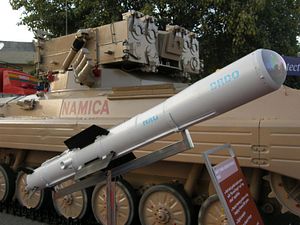India’s Defense Research and Development Organization (DRDO) successfully conducted a flight test of the third-generation anti-tank guided missile (ATGM) Nag, the Indian Ministry of Defense (M0D), announced in a September 9 press statement.
“India’s indigenously developed 3rd generation Anti-Tank Guided Missile (ATGM), Nag has been successfully flight tested twice by DRDO on 8-9-2017 against two different targets in the ranges of Rajasthan,” the press release reads. “The ATGM Nag missile has successfully hit both the targets under different ranges and conditions with very high accuracy as desired by the Armed Forces.”
According to the Indian MoD: “With these two successful flight trials, and the flight test conducted earlier in June in the peak of summer, the complete functionality of Nag ATGM along with launcher system NAMICA has been established and marked the successful completion of development trials of Nag Missile.”
Nag is a fire-and-forget ATGM with an estimated range of 4 kilometers. The Nag Missile Carrier (NAMICA) is an Indian license-produced variant of the Soviet-era BMP-II armored infantry fighting vehicle. NAMICA can launch Nag missiles from a retractable armored launcher that contains four launch tubes (the armored vehicle can carry up to 12 missiles in total) and the guidance package including a thermal imager for target acquisition. The missile’s targeting system is based on visual identification prior to its launch (‘lock-on-before-launch system’).
India has also been working on a more advanced air-launhced variant of the Nag, the Helina ATGM with a maximum range of up to seven kilometers. Once operational, the Helina will be part of the armaments of the indigenously designed Light Combat Helicopter (LCH) and the Hindustan Aeronautics Limited (HAL) Dhruv advanced light helicopters (ALH).
The Indian MoD announced the official launch of full-scale production of the LCH at the end of August. The Indian Army’s Army Aviation Corps (AAC) plans to induct a total of 114 LCH; the Indian Air Force placed an order for 65 helicopters. As I explained:
LCH prototypes have been undergoing extensive testing including high-altitude and weapons systems trials in 2016 and 2017. The LCH, which first took to the air in May 2010, has been developed to close a capability gap that became apparent during the 1999 Kargil War when the Indian military lacked attack helicopters capable of operating at high altitudes.
(…)
Consequently, the LCH, a derivative of the HAL Dhruv helicopter, has been primarily designed for high-altitude warfare – HAL and French engine-maker, Turbomeca jointly designed a special engine optimized for extreme altitudes – and has an operational ceiling limit of 6,000–6,500 meters (19,700–21,300 feet).
Initial operating capability for the LCH is expected by 2018. It is unclear when the Helina ATGM will become operational. As of now, the Indian military still lacks an air-launched anti-tank missile for its future fleet of combat helicopters.
































